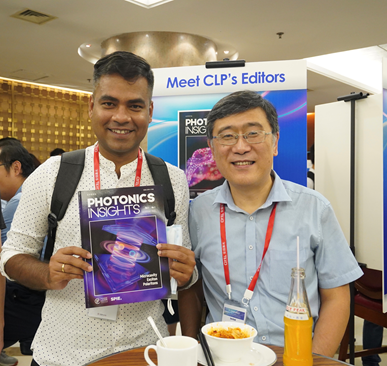Quantum Fluids of Light at Room Temperature
2022/08/16
Recently, the extraordinary developments of room temperature exciton polaritons, which can be referred as quantum fluids of light, is reported in a review paper led by the BAQIS scientists Professor Qihua Xiong and Associate Researcher Sanjib Ghosh. Exciton polaritons are promising optical systems to realize quantum phases of light, which ordinary light does not show. Invited by the Co-Editors-in-Chief Professor Lei Zhou from Fudan University and Professor Din Ping Tsai from City University of Hong Kong, this article is published and selected for the cover page of the inaugural issue of the Photonics Insights [1].
A commentary on this review article is written by Professor Alexey Kavokin from the University of Southampton and Westlake University, who is one of the leading scientists in the field [2]. In the commentary, he has mentioned that this article "provides an excellent development to the recent review on polaritonics for classical and quantum computing" and is "highly complementary" to his own book.
Exciton polaritons are hybrid quasiparticles of light and matter, which bring the speed of light and nonlinear interaction of excitons in a single platform. This unique composition poses the opportunity of various practical applications including but not limited to low threshold lasing, optical switches, polariton transistors, neuromorphic computing, polariton simulators, and possibly quantum computing.

Figure 1: Left, the cover page of the inaugural issue of the Photonics Insights. Right, the formation of exciton polaritons in semiconductor microcavities and their various properties [1].
Until recently, exciton polaritons are predominantly studied at extremely low temperatures (cryogenic temperatures), where bulky liquid helium (or nitrogen) chambers are required to cool down the system much below the lowest temperature ever experienced in Beijing during winters. This poses a serious disadvantage for the scalability which is a key requirement for practical applications. Fast forward to 21st century, the field has been revolutionized by the rapid development of room temperature exciton polaritons. Thanks to the remarkable success in the microcavity design with new types of semiconductors, now these quantum phases of light can be observed at room temperature without the need of bulky cryogenic instruments. This makes the room temperature microcavities highly suitable for quantum and classical optical devices.
The article presents an in-depth review of the recent theoretical and experimental developments. It starts with a general theoretical background with an introduction to the bosonic quantum field theory and progressively enters the mean-field description of exciton polariton condensates using a driven-dissipative version of the Gross-Pitaevskii equation. Most interestingly, it presents an up-to-date report on the promising application of exciton polaritons in quantum computing and simulation.
Although it was long expected that quantum states of exciton polaritons in microcavities can exist even at room temperature due to their extremely small effective mass, this was not realized until recently where new types of semiconductor-microcavities with larger exciton binding energies together with ultra-strong light-matter couplings are utilized. The development of these physical systems is comprehensively documented in this review paper. It includes an early development of GaN and ZnO based systems and elaborates on the emerging systems such as organics, halide perovskite semiconductors, carbon nanotubes, and transition metal dichalcogenides. While the required strong light-matter coupling is achieved in several types of semiconductor-microcavities, there are certain advantages and disadvantages for each of them. To have an overall idea of these physical platforms, a comparison between different systems is presented.
In conclusion, this comprehensive review paper will help to inspire the young students and stimulate the future research for further developments in the field.

Figure 2: BAQIS Associate Researcher Sanjib Ghosh with the Co-editor-in-Chief Professor Lei Zhou (Fudan University) of Photonics Insights. This high-quality journal is co-published by Chinese Laser Press (CLP) and SPIE and hosted by the Shanghai Institute of Optics and Fine Mechanics (SIOM), Chinese Academy of Sciences.
References:
[1] Sanjib Ghosh, Rui Su*, Jiaxin Zhao, Antonio Fieramosca, Jinqi Wu, Tengfei Li, Qing Zhang, Feng Li, Zhanghai Chen, Timothy Liew, Daniele Sanvitto, Qihua Xiong*, "Microcavity exciton polaritons at room temperature", Photonics Insights 1, R04 (2022)
[2] Alexey Kavokin*, “Liquid light at room temperature”, Photonics Insights 1, C02 (2022).
 中文
中文 Email
Email QCloud
QCloud Log in
Log in
